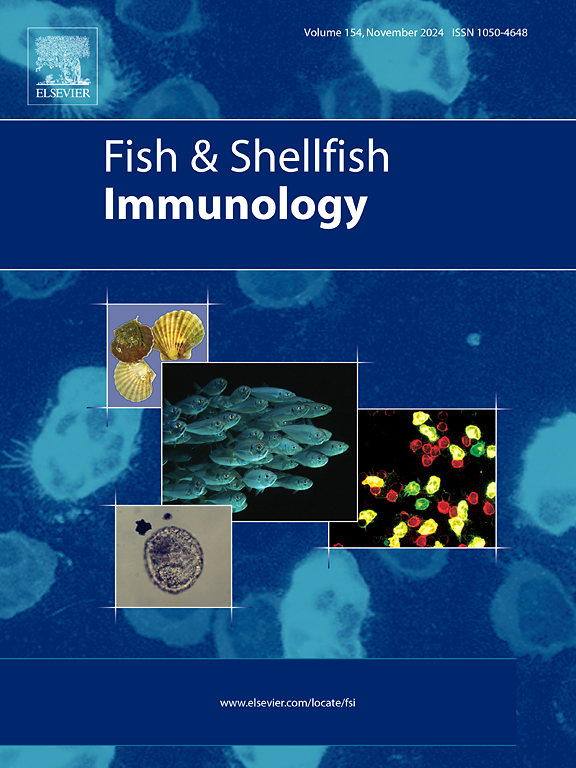一种香豆素衍生物 C7 通过减少虾体内的磷脂酰胆碱含量对 WSSV 具有抗病毒活性。
IF 4.1
2区 农林科学
Q1 FISHERIES
引用次数: 0
摘要
白斑综合征病毒(WSSV)会导致甲壳类水产养殖业出现严重的白斑病(WSD),造成重大经济损失。我们之前的研究表明,C7 是一种有效的治疗剂,可预防水产养殖中的 WSSV 感染。它能特异性地阻断病毒的水平传播,并以剂量和时间依赖性的方式降低对虾死亡率。在此,我们报告了 C7 在对虾体内的潜在抗病毒机制。C7能调节WSSV引起的甘油磷脂代谢异常,抑制磷脂酰胆碱(PC)合成2倍以上,从而增强对虾对病毒感染的抵抗力。作为细胞膜的主要磷脂,PC 是脂质过氧化反应的主要反应物之一。我们的研究结果表明,C7 能明显降低 WSSV 诱导的脂质过氧化产物 4- 羟基壬烯醛(4-HNE)和丙二醛(MDA)的水平,而 PC 的作用则相反。脂质过氧化产物的积累会抑制干扰素基因刺激器(STING)信号的传递。进一步的证据表明,C7 能促进 STING 从内质网向高尔基体运输,从而显著激活虾干扰素类似物 Vago4 基因的表达。相比之下,PC 则抑制 Vago4 基因的表达。我们的研究结果表明,C7 可抑制 PC 的合成,降低脂质过氧化程度,促进 STING 转位,激活 Vago4 的表达,并最终发挥抗病毒作用。因此,C7 具有免疫调节活性,是一种增强对虾先天免疫力的预防性药物,使其有可能用于未来的免疫调节方法。本文章由计算机程序翻译,如有差异,请以英文原文为准。
A coumarin derivative C7 exhibits antiviral activity against WSSV by reducing phosphatidylcholine content in shrimp
The white spot syndrome virus (WSSV) causes white spot disease (WSD), a severe condition in crustacean aquaculture, leading to significant economic losses. Our previous study demonstrated that C7 is an effective therapeutic agent against WSSV infection in aquaculture. It specifically blocked viral horizontal transmission and reduced shrimp mortality in a dose- and time-dependent manner. Here, we report the potential antiviral mechanism of C7 in shrimp. C7 regulated abnormal glycerophospholipid metabolism caused by WSSV and inhibited phosphatidylcholine (PC) synthesis by more than twofold, potentially enhancing shrimp resistance to viral infection. As the primary phospholipid in the cell membrane, PC is one of the main reactants in lipid peroxidation. Our results indicated that C7 significantly reduced the levels of lipid peroxidation products 4-hydroxynonenal (4-HNE) and malondialdehyde (MDA) induced by WSSV, whereas PC had the opposite effect. Accumulation of lipid peroxidation products inhibits stimulator of interferon genes (STING) signaling. Further evidence showed that C7 promoted STING transport from the endoplasmic reticulum to the Golgi apparatus, significantly activating the expression of the shrimp interferon analogue Vago4 gene. In contrast, PC suppressed Vago4 expression. Our results demonstrated that C7 inhibited PC synthesis, reduced the degree of lipid peroxidation, promoted STING translocation, activated Vago4 expression, and ultimately exerted antiviral effects. Therefore, C7 exhibits immunoregulatory activity as a preventative agent for enhancing the innate immunity of shrimp, making it potentially useful for future immunomodulatory approaches.
求助全文
通过发布文献求助,成功后即可免费获取论文全文。
去求助
来源期刊

Fish & shellfish immunology
农林科学-海洋与淡水生物学
CiteScore
7.50
自引率
19.10%
发文量
750
审稿时长
68 days
期刊介绍:
Fish and Shellfish Immunology rapidly publishes high-quality, peer-refereed contributions in the expanding fields of fish and shellfish immunology. It presents studies on the basic mechanisms of both the specific and non-specific defense systems, the cells, tissues, and humoral factors involved, their dependence on environmental and intrinsic factors, response to pathogens, response to vaccination, and applied studies on the development of specific vaccines for use in the aquaculture industry.
 求助内容:
求助内容: 应助结果提醒方式:
应助结果提醒方式:


